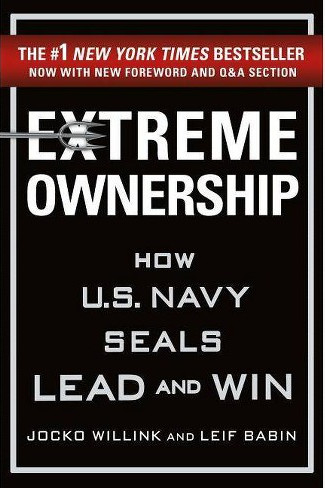Extreme Ownership, authored by Jocko Willink and Leif Babin, is a compelling book that delves into the principles of effective leadership and responsibility. Jocko Willink, a former U.S. Navy SEAL, and his co-author Leif Babin draw from their experiences in the military to provide insights that are not only applicable in the battlefield but also in various aspects of life, including business and personal development.
Summary of Extreme Ownership by Jocko Willink
Who is Jocko Willink?
Jocko Willink is a retired Navy SEAL who served for 20 years, including eight years as a SEAL officer. He led SEAL Team Three in some of the most dangerous and important missions of the Iraq War. Willink is now a popular author and speaker on leadership and personal development.
Introduction to “Extreme Ownership” by Jocko Willink
The book begins with the authors sharing a profound lesson they learned during their military careers: leadership is not about blaming others or making excuses. Instead, it’s about taking full responsibility for your actions and decisions. They coined the term “Extreme Ownership” to encapsulate this fundamental principle.

The Key Principles of Extreme Ownership
Taking Responsibility
In the first chapter, Willink and Babin emphasize that true leadership starts with acknowledging that you are responsible for everything in your world. This includes not only your direct actions but also the outcomes of your team.
Extreme Ownership is the belief that you are responsible for everything that happens in your life, both good and bad. It means taking full responsibility for your actions, your decisions, and your results. It also means being accountable to your team and to yourself as well as not making excuses and not blaming others.
When things go wrong, it’s easy to make excuses. But Willink believes that excuses are a sign of weakness and that they will only hold you back.
When you’re accountable, you’re willing to take responsibility for your actions and your results. You’re also willing to learn from your mistakes.
Leading Up and Down the Chain of Command
One of the critical lessons from their military service is that leadership is not exclusive to those in higher positions. Everyone in the organization has a role in leadership, from top-level executives to front-line employees.
The best leaders are those who lead by example. They set high standards for themselves and they hold themselves accountable to those standards.
Decentralized Command
Extreme Ownership encourages the delegation of authority to lower-level teams, allowing them to make decisions and take responsibility for their areas. This decentralization fosters quicker and more effective decision-making.
Prioritizing and Executing
Prioritization is vital in any leadership role. Willink and Babin stress the importance of clear and concise communication and a keen understanding of what truly matters.
The Dichotomy of Leadership
The authors explore the balance between being a leader who is both aggressive and prudent, disciplined and creative. They argue that a leader must master the ability to balance these seemingly contradictory traits.
Applying Extreme Ownership in Business
Case Study: Leadership in a Corporate Environment
The book provides numerous examples of how businesses have successfully applied the principles of Extreme Ownership. These case studies highlight how taking ownership and leading with clarity can lead to positive outcomes.
Empowering Teams
Extreme Ownership encourages leaders to empower their teams, giving them the autonomy to make decisions and take ownership of their tasks. This empowerment often results in increased morale and productivity.
Implementing Extreme Ownership in Personal Life
Taking Control of Your Actions
The book extends beyond the business realm and emphasizes that Extreme Ownership can also be applied in one’s personal life. Individuals can take control of their actions and decisions, leading to personal growth and self-improvement.
Resilience and Accountability
Extreme Ownership teaches the importance of resilience in the face of adversity. It encourages individuals to be accountable for their lives, even when faced with challenging circumstances.
In the Workplace
- Take ownership of your projects and your team’s performance.
- Don’t make excuses when things go wrong. Be accountable for your actions and results.
- Lead by example by setting high standards for yourself and your team.
At Home
- Take ownership of your relationships with your family and friends.
- Don’t make excuses when you make mistakes. Be accountable for your actions and apologize when necessary.
- Lead by example by being a positive role model for your loved ones.
In Your Relationships
- Take ownership of your role in your relationships.
- Don’t make excuses for your partner’s behavior. Be accountable for your own actions and feelings.
- Lead by example by being a loving and supportive partner.
Benefits of Practicing Extreme Ownership
Improved Decision-Making
One of the significant benefits of adopting the principles of Extreme Ownership is the improvement in decision-making. Clear ownership of actions leads to better choices and outcomes.
Enhanced Teamwork and Communication
Effective leadership and ownership foster better teamwork and communication within a group, leading to more harmonious and productive environments.
Overcoming Adversity
Extreme Ownership equips individuals and teams to confront adversity with confidence and determination, ultimately overcoming challenges.
Criticisms and Challenges
While Extreme Ownership has gained popularity and received widespread praise, it is not without its criticisms and challenges. Some argue that its rigid approach may not be suitable for all situations, and implementing it can be challenging in practice.
Conclusion
In conclusion, “Extreme Ownership” by Jocko Willink is a remarkable guide to leadership, responsibility, and personal development. It teaches that by taking ownership of your actions and decisions, you can lead effectively and achieve success in various aspects of life. The book’s principles have been successfully applied in the military, corporate world, and personal life, making it a valuable resource for anyone seeking to improve their leadership skills.
FAQs
1. What is the main concept behind Extreme Ownership?
The main concept of Extreme Ownership is taking full responsibility for your actions and decisions, both individually and as part of a team or organization.
2. How can Extreme Ownership be applied in a corporate setting?
Extreme Ownership can be applied in a corporate setting by empowering employees, promoting clear communication, and fostering a culture of accountability and responsibility.
3. Are there any criticisms of Extreme Ownership?
Yes, Extreme Ownership has faced criticism for its rigid approach, which may not be suitable for all situations, and its challenges in practical implementation.
4. Can the principles of Extreme Ownership be applied in personal life?
Absolutely, the principles of Extreme Ownership are not limited to professional settings and can be applied in personal life to improve decision-making, resilience, and accountability.
5. What are the benefits of practicing Extreme Ownership?
Benefits of practicing Extreme Ownership include improved decision-making, enhanced teamwork and communication, and the ability to overcome adversity with confidence.




